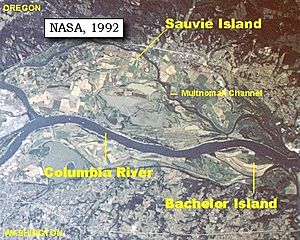Bachelor Island (Washington) facts for kids
Bachelor Island is a cool island located in the Columbia River in the state of Washington. You can find it close to a town called Ridgefield. It's just a bit south of where the Lewis River flows into the Columbia, and a little north of the Willamette River's mouth. The island is about 3.5 miles (5.6 km) long. The northern part of Sauvie Island is right across the Columbia River from Bachelor Island.
Bachelor Island isn't directly connected to the mainland. It's separated by a waterway called Bachelor Island Slough and another river called Lake River. The slough starts from the Columbia River at the southern end of Bachelor Island. It then joins Lake River, which flows back into the Columbia River at the northern tip of the island.
Most of Bachelor Island is a protected area. It's part of the Ridgefield National Wildlife Refuge. This refuge helps protect many different kinds of animals and plants that live there.
Island History
People have known about Bachelor Island for a long time. Here's how its name changed over the years:
Early Names
When the famous explorers Lewis and Clark first saw the island in 1805, they called it "Green Bryor Isd." They were traveling down the Columbia River at the time.
Later, in 1806, when they were heading back upriver, they changed the name. They called it "Quathlahpotle Island." This new name honored a large Native American village nearby. That village, also called Quathlahpotle, had 14 wooden houses and was home to about 900 people.
Other Names
In 1841, another explorer named Charles Wilkes visited the area. He was part of the United States Exploring Expedition. Wilkes gave the island a new name, "Pasainks Island." He also named the waterway separating it from the mainland "Piscou Creek." For a while in the 1800s, some people even called it Columbia Island.
How it Got its Name
The island got its current name, Bachelor Island, in 1849 or 1850. This was because three single men, often called "bachelors," decided to settle there. They claimed land under a law called the Donation Land Claim Act. Their presence gave the island the name it still has today!


